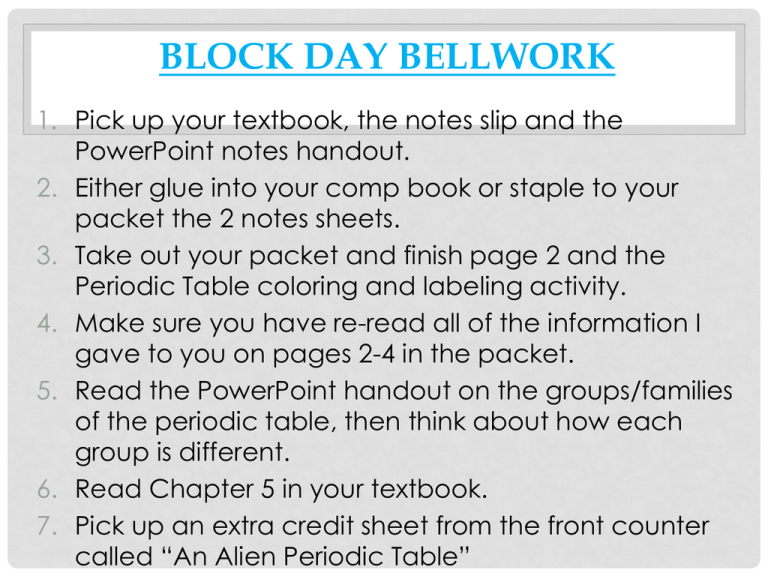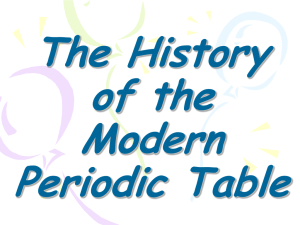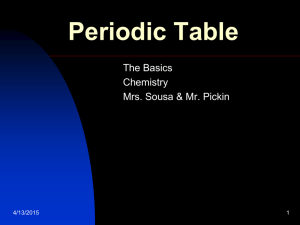Metals, Nonmetals and Metalloids
advertisement

BLOCK DAY BELLWORK 1. Pick up your textbook, the notes slip and the PowerPoint notes handout. 2. Either glue into your comp book or staple to your packet the 2 notes sheets. 3. Take out your packet and finish page 2 and the Periodic Table coloring and labeling activity. 4. Make sure you have re-read all of the information I gave to you on pages 2-4 in the packet. 5. Read the PowerPoint handout on the groups/families of the periodic table, then think about how each group is different. 6. Read Chapter 5 in your textbook. 7. Pick up an extra credit sheet from the front counter called “An Alien Periodic Table” Scientist Discovery Picture Democritis The 1st person Around 430BC to propose the idea of the atom John Proposed Dalton - the ATOMIC 1802 theory Thompson- Discovered that 1897 atoms have negative ELECTRONS and thought they were spread throughout a positive ball Rutherford- Discovered that 1909 positive PROTONS are in a NUCLEUS and electrons move around them Bohr-1913 Electrons move in rings around the nucleus Schroding Electrons are er-1920 in a “cloud” around the nucleus Chadwic Discovered k-1932 NEUTRONS in the nucleus Dalton’s Atomic Theory Although two centuries old, Dalton's atomic theory remains valid in modern chemical thought. Modern atomic theory is, of course, a little more involved than Dalton's theory but the essence of Dalton's theory remains valid. 1) All matter is made of atoms. Atoms are indivisible and indestructible. 2) All atoms of a given element are identical in mass and properties 3) Compounds are formed by a combination of two or more different kinds of atoms. 4) A chemical reaction is a rearrangement of atoms Metals, Nonmetals and Metalloids Coloring in the Periodic Table Notice the difference between the appearance of the metals and nonmetals. Click here for a better view of each of the elements. Physical properties of METALS • Metals are SOLIDS. (except mercury) • Metals are HARD. (except Lithium, Potassium, Sodium) Physical Properties of METALS Metals have shiny luster. (or metallic luster) LUSTER – the way an object’s surface reflects light When you leave a spoon in a cup of hot drink, the bit poking out of the drink gets hot. Why? Conduction! METALS are the best conductors of heat. This is because the electrons in metals move more freely than in non-metals, allowing the heat energy to travel across the metal. For example, when the spoon touches the hot drink, the heat from the drink excites the electrons in the metal, and the electrons transfer the energy from one electron to another, carrying the heat all the way up the spoon quickly. Best conductors: silver and copper Physical Properties of METALS • Metals are good conductors of electricity. Copper, silver, and gold are good electrical conductors. In a conductor, electric current can flow freely. Since metals have free electrons, they can carry a charge easily. Copper Wiring Physical Properties of METALS Metals are malleable. Malleable or Malleability - metals ability to be shaped or formed as by hammering or pressure; can be beaten into thin sheets Aluminum is malleable. Physical Properties of METALS Metals are ductile. Ductility or ductile – can be drawn into a wire Examples of NONMETALS Non metals may be solids, liquids or gases. Examples: Solids – Carbon, Sulfur, Phosphorus Liquid – Bromine Gases – Oxygen, Hydrogen, Nitrogen Physical Properties of NONMETALS Nonmetals have a dull luster. (They are not shiny!) Example: Phosphorus Physical Properties of NONMETALS Nonmetals are insulators. They do not conduct electricity or heat well. The atoms in nonmetals do not have loose electrons. Therefore, when electricity, or something hot touches a non-metal, the energy does not move quickly through the material. What would you rather stir a hot pot with—a wooden spoon or a metal spoon? Physical Properties of NONMETALS Nonmetals are soft (except for diamonds and brittle. Example: Sulfur An interesting element: Carbon Ever break the point of your pencil? That’s because it’s made of graphite, a substance made up completely of Carbon—a brittle nonmetal. However diamonds, the hardest material of all, are made of the same element: Carbon. Look at how the carbon atoms are arranged in diamonds—why do you think diamonds are harder than graphite? Carbon atoms in graphite METALLOIDS The elements contained in the classification of Metalloids: METALLOIDS • Elements classified as Metalloids have physical properties of both metals and non-metals. • Some are shiny, some are dull, they are somewhat malleable and ductile, and can conduct heat and electricity at a lesser level than metals. SILICON BORON ARSENIC METALLOIDS • Some metalloids are useful semiconductors, which are used in electronics (radio, computers, telephones, etc.) • They are useful because they conduct just the right amount of electricity or heat. Where do we find METALS? Some metals like gold, silver, and platinum are found as pure substances in the earth’s crust because they are least reactive. Most metals are reactive and are found as oxides (react with oxygen), carbonates (react with carbon), sulfides (react with sulfur). Minerals : are elements or compounds which occur naturally inside the earth’s crust. Ore : is a mineral from which metals can be extracted profitably. In your packet… • There are 2 charts to fill out classifying properties of metals, nonmetals and metalloids Important Vocabulary • Valence Electrons • Bohr Diagram • Lewis Dot Diagram/Lewis Structure • https://www.youtube.com/watch?v=rSwnO DMNULI&feature=youtu.be Bohr Diagrams and Lewis Dot Structures What you’ve already learned in class and from readings • You learned that Electrons can exist in different energy levels • You learned that the # of Electrons in an atom are equal to the # of Protons in an atom • You learned that the # of Valence Electrons are the outermost Electrons of an Atom What You’re about to learn (Find it in your Packet!) 1. How to draw the Electrons around an Atom in a Bohr Diagram 2. How many Electrons are found in any Element’s Valence Shell 3. How to draw a Lewis Structure Notes • A Bohr Diagram is the model of an atom with the Nucleus at the center, and the Electrons drawn around it on different energy levels. First Steps in Bohr Model • Find the amount of each subatomic particle in the atom p= e= n= • Know how many electrons can fit in each ring and write the electron configuration – 2-8-18-32 Now for some practice • • • • For an Atom of Hydrogen: 1 Electron! The electron configuration is just 1 Simple, you just draw the first Electron here • The number of protons and neutrons get written in the nucleus. Next • For an Atom of Helium: • 2 Electrons! The electron configuration is 2 • Simple, you just draw the second Electron here More • For an Atom of Lithium: • 3 Electrons! • But wait a minute…We said that only 2 Electrons can fit into the first level • So What do we do when it’s full???? WE ADD ANOTHER LEVEL!!! • That’s right, the first energy level is full • Now we add another level!!! • This new level can hold up to 8 Electrons!!! So • For an Atom of Lithium: • 3 Electrons! The electron configuration is 2-1 • Simple, you just draw the third Electron here Then What? • When you run out of room on the second level, you add a third that can hold another 18 Electrons, then a fourth that can hold another 32 Electrons, (but we won’t worry about that level right now) You should Know by Now • How to draw a Bohr Diagram • That the –1st energy level can hold 2 e–The 2nd can hold 8 e–The 3rd can hold 18 e- Finally: Lewis Structures • All you have to do for a Lewis Structure is draw Dots around an Element’s Symbol • But How Many???? What you are about to learn 1. How many Electrons are found in any Element’s Valence Shell 2. How to draw a Lewis Structure So… • The amount of dots you draw for a Lewis Structure (LS for short) is equal to the # of Valence Electrons in an Atom Valence Electrons • The # of Valence e- an atom has is dictated by the Group the Element is in • Groups are the Vertical Columns on the Periodic Table!!! It’s So Simple!!!! Review of Terms (make sure in notes!) • • • • Electron configuration Valence electrons Bohr Diagram Lewis Dot Diagram/Lewis Structure To Do 1. Finish all of pages 1-5 in your packet. Make sure you understand all content – ask questions if you need to. 2. Read and complete Chapter 5 in your textbook. 3. Alien Periodic Table Extra Credit Challenge If time, we will do an element matching card activity and go over pages 1-5 after I check them in your packet – show me when








